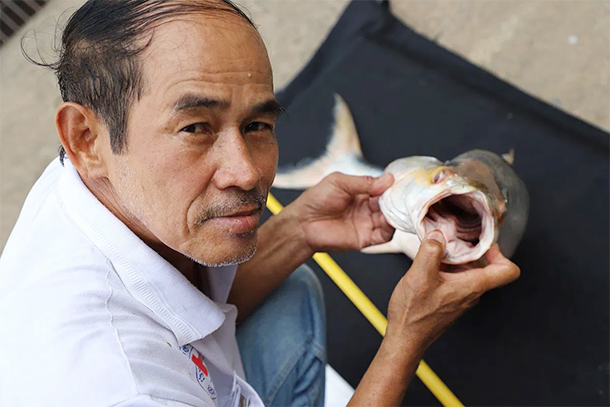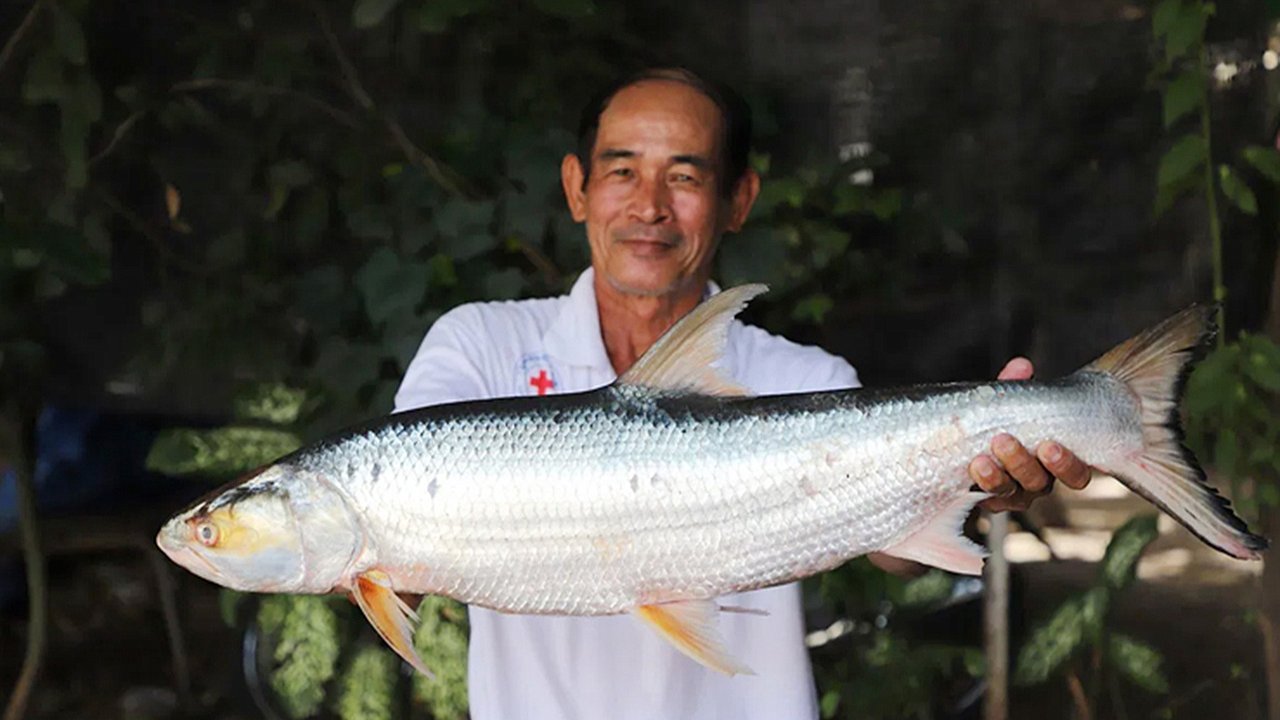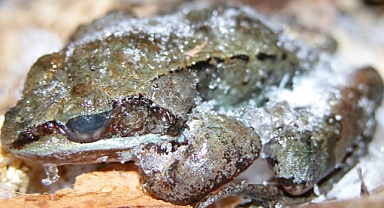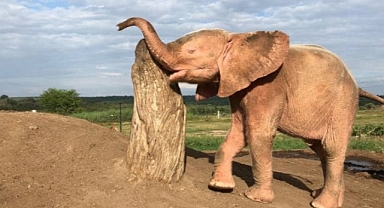A Ghost Reappears
The excitement began in 2020 when word spread that an unusual fish had been caught in Cambodia. Its distinct features—a protruding knob at the jaw and a peculiar-shaped mouth—matched descriptions of the elusive Mekong Ghost. However, the fish was sold at a market before scientists could verify it, leaving them uncertain about the discovery. Zeb Hogan, a biologist from the University of Nevada, Reno, and leader of the Wonders of the Mekong project, described it as an intriguing but incomplete lead.Three years later, the breakthrough arrived. Cambodian fishermen captured two giant salmon carps, weighing between 11 and 13 pounds and measuring up to three feet in length. This time, researchers were able to examine the fish directly. “The fishermen knew they had something remarkable,” Hogan said. “As soon as we saw the photos, we knew it was the Mekong Ghost.”A Beacon of Hope
The discovery, published in the Biological Conservation journal, was a significant win for conservationists working to preserve the Mekong River, which flows through Southeast Asia and sustains millions of people. Known as the "Mother of Rivers," the Mekong is home to over 1,100 fish species, many of which are endemic. However, the river faces severe environmental threats, including hydropower projects, overfishing, and climate change. The giant salmon carp, which can grow up to four feet and weigh 66 pounds, is particularly vulnerable to these challenges. Since its formal identification in 1991, fewer than 30 individual fish had been recorded, leading many scientists to fear the species had disappeared for good. “This rediscovery offers a glimmer of hope—not just for this species, but for the entire Mekong ecosystem,” said Bunyeth Chan, a researcher from Svay Rieng University and the study’s lead author.Unanswered Questions
The giant salmon carp, which can grow up to four feet and weigh 66 pounds, is particularly vulnerable to these challenges. Since its formal identification in 1991, fewer than 30 individual fish had been recorded, leading many scientists to fear the species had disappeared for good. “This rediscovery offers a glimmer of hope—not just for this species, but for the entire Mekong ecosystem,” said Bunyeth Chan, a researcher from Svay Rieng University and the study’s lead author.Unanswered Questions
Though the rediscovery is encouraging, much remains unknown. Scientists are unsure how many giant salmon carps exist or where they are concentrated. Interestingly, the three fish discovered between 2020 and 2023 were found outside their usual habitat range, raising questions about whether these populations had migrated from neighboring Laos or Thailand or if they inhabit previously uncharted areas.Hogan credits the discovery to the close relationships his team has built with local communities, encouraging fishermen to report unusual catches. However, challenges persist. Climate change has exacerbated extreme weather in the region, while human activities such as sand mining and dam construction continue to degrade the Mekong’s ecosystem. Nearly 20% of the river’s fish species are now threatened with extinction, according to a report released earlier this year by 25 conservation organizations, including the World Wildlife Fund.Conservation Amid Political Challenges
Cambodia’s complex political environment adds another layer of difficulty for conservation efforts. Environmental activists have faced persecution, with several jailed or killed for opposing projects linked to habitat destruction. In 2023, ten members of the activist group Mother Nature Cambodia were sentenced to prison on charges of conspiring against the state, a move condemned by global environmental figures such as Greta Thunberg.Despite these obstacles, Hogan and his team hope the rediscovery of the Mekong Ghost can galvanize efforts to protect the region’s biodiversity. The next step involves creating a cross-border research initiative with scientists from Cambodia, Laos, and Thailand to monitor and conserve this rare fish.“This fish is an indicator of river health,” Hogan explained. “Its survival reflects the wellbeing of other fish species crucial to local livelihoods and food security.”A Symbol of River Conservation
The rediscovery of the giant salmon carp serves as a powerful reminder of what’s at stake. As the Mekong River faces mounting environmental pressures, protecting vulnerable species like the Mekong Ghost has become a priority. For Hogan and other conservationists, the fish’s reappearance is more than just a scientific triumph—it’s a sign that the battle to save the river is not yet lost.
The excitement began in 2020 when word spread that an unusual fish had been caught in Cambodia. Its distinct features—a protruding knob at the jaw and a peculiar-shaped mouth—matched descriptions of the elusive Mekong Ghost. However, the fish was sold at a market before scientists could verify it, leaving them uncertain about the discovery. Zeb Hogan, a biologist from the University of Nevada, Reno, and leader of the Wonders of the Mekong project, described it as an intriguing but incomplete lead.Three years later, the breakthrough arrived. Cambodian fishermen captured two giant salmon carps, weighing between 11 and 13 pounds and measuring up to three feet in length. This time, researchers were able to examine the fish directly. “The fishermen knew they had something remarkable,” Hogan said. “As soon as we saw the photos, we knew it was the Mekong Ghost.”A Beacon of Hope
The discovery, published in the Biological Conservation journal, was a significant win for conservationists working to preserve the Mekong River, which flows through Southeast Asia and sustains millions of people. Known as the "Mother of Rivers," the Mekong is home to over 1,100 fish species, many of which are endemic. However, the river faces severe environmental threats, including hydropower projects, overfishing, and climate change.
 The giant salmon carp, which can grow up to four feet and weigh 66 pounds, is particularly vulnerable to these challenges. Since its formal identification in 1991, fewer than 30 individual fish had been recorded, leading many scientists to fear the species had disappeared for good. “This rediscovery offers a glimmer of hope—not just for this species, but for the entire Mekong ecosystem,” said Bunyeth Chan, a researcher from Svay Rieng University and the study’s lead author.Unanswered Questions
The giant salmon carp, which can grow up to four feet and weigh 66 pounds, is particularly vulnerable to these challenges. Since its formal identification in 1991, fewer than 30 individual fish had been recorded, leading many scientists to fear the species had disappeared for good. “This rediscovery offers a glimmer of hope—not just for this species, but for the entire Mekong ecosystem,” said Bunyeth Chan, a researcher from Svay Rieng University and the study’s lead author.Unanswered QuestionsThough the rediscovery is encouraging, much remains unknown. Scientists are unsure how many giant salmon carps exist or where they are concentrated. Interestingly, the three fish discovered between 2020 and 2023 were found outside their usual habitat range, raising questions about whether these populations had migrated from neighboring Laos or Thailand or if they inhabit previously uncharted areas.Hogan credits the discovery to the close relationships his team has built with local communities, encouraging fishermen to report unusual catches. However, challenges persist. Climate change has exacerbated extreme weather in the region, while human activities such as sand mining and dam construction continue to degrade the Mekong’s ecosystem. Nearly 20% of the river’s fish species are now threatened with extinction, according to a report released earlier this year by 25 conservation organizations, including the World Wildlife Fund.Conservation Amid Political Challenges
Cambodia’s complex political environment adds another layer of difficulty for conservation efforts. Environmental activists have faced persecution, with several jailed or killed for opposing projects linked to habitat destruction. In 2023, ten members of the activist group Mother Nature Cambodia were sentenced to prison on charges of conspiring against the state, a move condemned by global environmental figures such as Greta Thunberg.Despite these obstacles, Hogan and his team hope the rediscovery of the Mekong Ghost can galvanize efforts to protect the region’s biodiversity. The next step involves creating a cross-border research initiative with scientists from Cambodia, Laos, and Thailand to monitor and conserve this rare fish.“This fish is an indicator of river health,” Hogan explained. “Its survival reflects the wellbeing of other fish species crucial to local livelihoods and food security.”A Symbol of River Conservation
The rediscovery of the giant salmon carp serves as a powerful reminder of what’s at stake. As the Mekong River faces mounting environmental pressures, protecting vulnerable species like the Mekong Ghost has become a priority. For Hogan and other conservationists, the fish’s reappearance is more than just a scientific triumph—it’s a sign that the battle to save the river is not yet lost.









